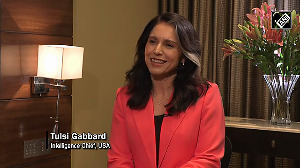Gallup India's Principal Consultant Rajesh Srinivasan believes measuring the emotional connect between company and customer will reflect the true health of customer relationships, and explains a measure of customer engagement.
Most businesses today accept that customers don't want to be satisfied merely in a rational way.
They're looking for an emotional connect with the banks where they handle their financial transactions, the retail outlets where they do their regular shopping and the hotels where they stay.
Needless to say, it is difficult to measure and manage these emotional relationships with customers.
Consequently, marketers have focused more on the tangible benefits arising from features in a product or economic benefits from a promotion, without necessarily building a strong relationship with the brand or the service provider.
But that's imperative if you want the customer to keep coming back. The trick is to devise a metric that measures both, the 'rational' drivers and the 'emotional' component of customer satisfaction.
The result is customer engagement. Admittedly, it is difficult to measure, but companies that make the effort find that the payoff is multifold -- engaged customers buy more and buy more often; they are often willing to pay a premium; they cost less; and importantly, are more ready to forgive when a problem occurs with the service or the product.
Our market and opinion research consultancy has developed a measure of Customer Engagement that we call CE11, based on research carried out in the US in 2000 and replicated in India in 2002.
Going beyond the traditional measures of satisfaction, loyalty and advocacy, we quantified the strength of the relationship built on the basis of meeting the emotional needs of the customer.
Research covering over 3,000 respondents in six different product categories (airlines, automotives, online retail, mass merchandise, consumer banking and consumer electronics) and a battery of over 60 attributes uncovered four basic dimensions of emotional needs starting from basic to higher order needs. Here's how they work:
Confidence
At the base of the hierarchy of customer engagement is confidence -- the customer's belief that the company will keep its promises. And companies' reputations are based on how often they deliver on promises.
Promises are nothing but moments of truth at every touch point (whether it is a call centre agent picking up a call in two rings, or an ATM machine that is able to dispense the right amount of cash or the Teller at the branch who is efficient, knowledgeable and courteous). This is not about 'usually' doing a good job, or 'trying' to do your best -- it's about 'always.'
Integrity
Next on the hierarchy is integrity. When a customer trusts a company, he doesn't expect things to always be perfect.
He accepts that sometimes there will be problems; but he expects the company to adopt a problem-solving approach, rather than play a blame game. The question is: what are the standards with which the company operates and how fair are they from a customers' perspective?
If a company plays fair, attempts to solve problems, and communicates effectively with its customers, it will score high on integrity. And it has been our experience that often when people have successfully come through problems along with a company, they actually become more involved with it.
Pride
Pride of association creeps in when customers believe they are valued and respected for the business they provide, reflected in the form of courtesy, special treatment and more importantly, respect.
Loyalty programmes typically help reinforce that sense of pride. You fly with a particular airline and log more miles, and you get treated as a special passenger. You carry a card that reflects your special status and that entitles you to privileges not accorded to less loyal customers.
Badge products (such as Rolex, Jaguar and MontBlanc) evoke that sense of pride. In India especially, customers take pride in owning multinational brands.
But, remember, this pride has to be fundamentally built on top of meeting the lower order emotional needs of confidence and integrity.
Otherwise it will be transient, because the experiences of the customer with the brand/service provider over a period of time will not reinforce that sense of pride. Pride cannot compensate for poor delivery on promises made or ineffective problem resolution.
Passion
At the height of a customer's emotional needs is passion. This defines the strong emotional connect the customer feels with the brand, so much so that there is a sense of irreplaceability about it -- the customer can't imagine life without the brand or product.
Starbucks is a perfect example: loyalists of the coffee chain will tell you that they can't imagine life without its coffee. They will walk five blocks to get their daily dose of caffeine from a Starbucks outlet rather than settle for a cup from the nearby café. There's a sense of pride as well as passion about such brands.
Sometimes, it doesn't work out that well. Jaguar is a case in point. The old saw was that Jag owners needed two Jaguars: one to drive around and one for the workshop.
The message was clear: although owning a Jaguar connoted a certain status, the product was not dependable. The passion had been created without the delivery of the inherent promise. (Of course, that's now changed greatly.)
The difference between confidence and passion is that while confidence is about good products and good people supporting the product, passion is created through great products and excellent people.
In India, consider Woodward gripe water or Johnson's baby powder -- most new parents would consider this an indispensable part of their nurseries.
Woodward's has become completely irreplaceable for generations of parents because it not only met the basic need of customers, but also evoked a sense of trust through its heritage.
How is the CE11 measured? Essentially, the CE11 is a metric that considers 11 issues.
Each of the 11 items that form the CE11 is measured on a five-point scale, with five being a strong positive response and one a strong negative response.
Since customer engagement is an outcome, in a typical survey, these 11 questions are asked first for the specific brand/service provider before we drill down to the attributes that impact this outcome.
In addition, the survey includes other measures such as value for money, experience with various touchpoints, problem incidence and resolution. These attributes are referred to as 'drivers' as they impact the engagement.
Who is interviewed to arrive at the CE11 metric depends on the nature of the business. When customers are the end-users of the product or service (a hotel or bank, for instance), we speak to them.
But in a business-to-business environment, there are multiple people involved in the decision making and so we interview both the key decision-maker and the influencer.
Of course, it's not easy convincing companies that they're falling short of achieving customer engagement.
The immediate rejoinder is always along the lines of 'You must not have spoken with the right customers' or 'The sample size is not adequate to draw such inferences' and so on.
Often, management gets to hear only the good news from the sales teams, so findings such as these come as a shock.
But a good way to evaluate whether building customer engagement is worthwhile or not is to look at the repeat business and business expansion of those customers who are designated as 'fully engaged.'
That should provide organisations a powerful motivation to take a second look at customer engagement.
As told to Meenakshi Radhakrishnan-Swami







 © 2025
© 2025